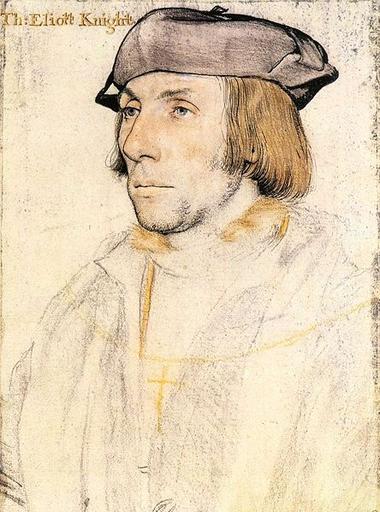MAKE A MEME
View Large Image

| View Original: | Sir_Thomas_Elyot,_preparatory_sketch_by_Holbein.jpg (444x599) | |||
| Download: | Original | Medium | Small | Thumb |
| Courtesy of: | www.flickr.com | More Like This | ||
| Keywords: portrait 16th century 16thcentury tudors nobility english united englishunited kingdom britain Portrait of Sir Thomas Elyot. Chalk, pen and brush on pink-primed paper, 28.6 × 20.6 cm, Royal Collection, Windsor. Sir Thomas Elyot (c. 1490–1546) was a diplomat, Member of Parliament, and a humanist writer, part of the circle around Sir Thomas More. Holbein made this study, along with that of Elyot's wife, Margaret, for matching paintings now lost. Both drawings are strongly reinforced with Indian ink around the heads and headgear, a technique absent in the portrait studies of Holbein's first English period. Dating from the earliest stage of his second stay in England, which started in 1532, the drawing is unusually well preserved, down to the white chalk heightening on Elyot's nose. The sitter wears his hair long, in the older fashion. At the time of this drawing, Elyot had just returned from a hopeless mission to persuade Emperor Charles V to accept Henry VIII's treatment of his aunt Katherine of Aragon. As a friend of Thomas More, however, Eliot was suspected of favouring Katherine over Anne Boleyn. Holbein indicates in this drawing that Elyot is wearing a crucifix on a chain, a sign of his traditional faith. In 1531, Elyot had lamented the standard of native-born artists, complaining that the English "be constrayned, if we will have anything well paynted, kerved, or embrawdered, to abandone our own countraymen and resorte unto strangers". Portrait of Sir Thomas Elyot. Chalk, pen and brush on pink-primed paper, 28.6 × 20.6 cm, Royal Collection, Windsor. Sir Thomas Elyot (c. 1490–1546) was a diplomat, Member of Parliament, and a humanist writer, part of the circle around Sir Thomas More. Holbein made this study, along with that of Elyot's wife, Margaret, for matching paintings now lost. Both drawings are strongly reinforced with Indian ink around the heads and headgear, a technique absent in the portrait studies of Holbein's first English period. Dating from the earliest stage of his second stay in England, which started in 1532, the drawing is unusually well preserved, down to the white chalk heightening on Elyot's nose. The sitter wears his hair long, in the older fashion. At the time of this drawing, Elyot had just returned from a hopeless mission to persuade Emperor Charles V to accept Henry VIII's treatment of his aunt Katherine of Aragon. As a friend of Thomas More, however, Eliot was suspected of favouring Katherine over Anne Boleyn. Holbein indicates in this drawing that Elyot is wearing a crucifix on a chain, a sign of his traditional faith. In 1531, Elyot had lamented the standard of native-born artists, complaining that the English "be constrayned, if we will have anything well paynted, kerved, or embrawdered, to abandone our own countraymen and resorte unto strangers". | ||||